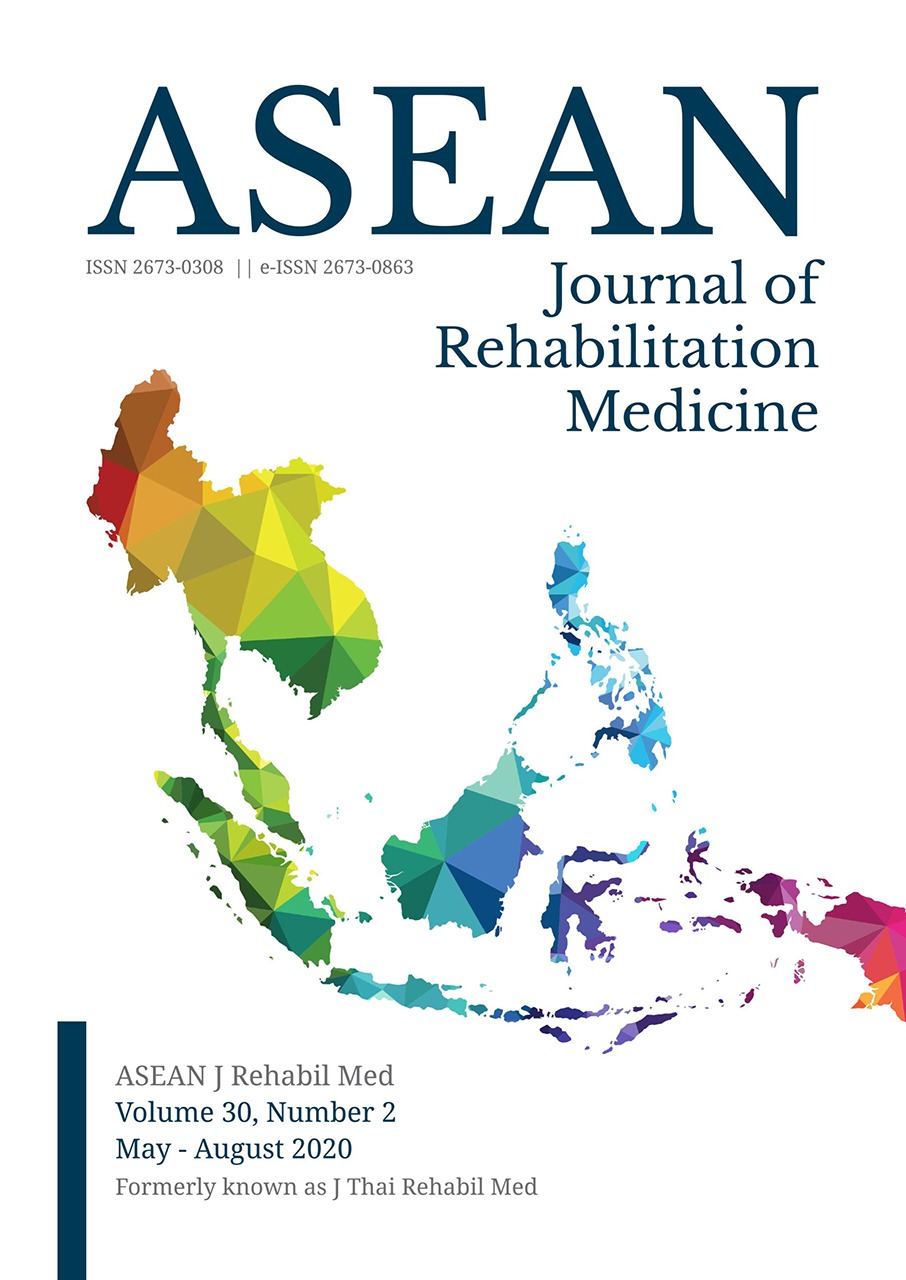The Outcomes of Seamless Self-care Training between Occupational Therapist and Nurse in Stroke Patients
Keywords:
self-care, nursing care, occupational therapy, inpatient, stroke rehabilitationAbstract
Objectives: To investigate the outcomes of seamless self-care training to stroke patients by occupational therapists (OTs) and nurses.
Study design: Quasi-experimental research design.
Setting: Rehabilitation ward, Siriraj Hospital, Mahidol University.
Subjects: Thirty-five inpatients with first stroke, normal mental functions and age between 18 to 75 years old, were included in the study. All needed help in dressing and washing oneself activities.
Methods: Participants were divided into two groups. The conventional group received self-care (dressing and washing oneself) training from OTs for 3 days; on day 4, OTs supervised them, thereafter nursing staffs were responsible for such activities in a traditional nursing care until day 14. The experimental group received a “seamless self-care training”, in which OTs trained patients for 2 days, supervised them for the next 2 days, and the nursing staffs joined the OTs on day 4 to learn how to facilitate the patients and led the training until day 14. The primary outcome was a normalized gain of the self-care score. Secon-dary outcomes were a modified Barthel index (MBI) score, self-efficacy, and patient satisfaction. The outcomes were evaluated at baseline (day 1) and after completing the training (day 14).
Results: After adjusting by normalized gain calculation, there were significantly more participants in the experimental group who achieved a higher gain level (0.7-1) than in the conventional group (p = 0.028). The experimental group had considerably higher self-efficacy for washing oneself activity after the training (p = 0.013) and were more satisfied with the training program than the conventional group. The MBI improved in both groups.
Conclusion: This seamless self-care training with good colla-boration between occupational therapists and nursing staffs during inpatient rehabilitation was proved to be effective in dressing and washing oneself training and promoting self-efficacy of stroke patients
References
Disease GBD, Injury I, Prevalence C. Global, regional, and national incidence, prevalence, and years lived with disability for 354 diseases and injuries for 195 countries and territories, 1990-2017: a systematic analysis for the Global Burden of Disease Study 2017. Lancet. 2018;392:1789-858.
Miller EL, Murray L, Richards L, Zorowitz RD, Bakas T, Clark P, et al. Comprehensive overview of nursing and interdisciplinary rehabilitation care of the stroke patient: a scientific statement from the American Heart Association. Stroke. 2010;41:2402-48.
Umehara T, Tanaka R, Tsunematsu M, Sugihara K, Moriuchi Y, Yata K, et al. Can the amount of interventions during the convalescent phase predict the achievement of independence in activities of daily living in patients with stroke? A retrospective cohort study. J Stroke Cerebrovasc Dis. 2018;27:2436-44.
Morone G, Paolucci S, Iosa M. In what daily activities do patients achieve independence after stroke? J Stroke Cerebrovasc Dis. 2015;24:1931-7.
Winstein CJ, Stein J, Arena R, Bates B, Cherney LR, Cramer SC, et al. Guidelines for adult stroke rehabilitation and recovery: a guideline for healthcare professionals from the American Heart Association/American Stroke Association. Stroke. 2016;47:e98-169.
Singh R, Kucukdeveci AA, Grabljevec K, Gray A. The role of interdisciplinary teams in physical and rehabilitation medicine. J Rehabil Med. 2018;50:673-8.
Quinn TJ, Paolucci S, Sunnerhagen KS, Sivenius J, Walker MF, Toni D, et al. Evidence-based stroke rehabilitation: an expanded guidance document from the European Stroke Organisation (ESO) guidelines for management of ischaemic stroke and transient ischaemic attack 2008. J Rehabil Med. 2009;41:99-111.
Long AF, Kneafsey R, Ryan J. Rehabilitation practice: challenges to effective team working. Int J Nurs Stud. 2003;40:663-73.
Pryor J. A nursing perspective on the relationship between nursing and allied health in inpatient rehabilitation. Disabil Rehabil. 2008;30:314-22.
Long AF, Kneafsey R, Ryan J, Berry J. The role of the nurse within the multi-professional rehabilitation team. J Adv Nurs. 2002;37:70-8.
Muangpaisan W, Assantachai P, Sitthichai K, Richardson K, Brayne C. The distribution of Thai Mental State Examination scores among non-demented elderly in suburban Bangkok metropolitan and associated factors. J Med Assoc Thai. 2015;98: 916-24.
Williams LS, Brizendine EJ, Plue L, Bakas T, Tu W, Hendrie H, et al. Performance of the PHQ-9 as a screening tool for depression after stroke. Stroke. 2005;36:635-8.
Hake RR. Interactive-engagement versus traditional methods: a six-thousand-student survey of mechanics test data for introductory physics courses. Am J Physics. 1998;66:64-74.
Mukaka MM. Statistics corner: a guide to appropriate use of correlation coefficient in medical research. Malawi Med J. 2012;24:69-71.
Collin C, Wade DT, Davies S, Horne V. The Barthel ADL Index: a reliability study. Int Disabil Stud. 1988;10:61-3.
Kuptniratsaikul V, Kovindha A, Massakulpan P, Permsirivanich W, Kuptniratsaikul PS. Inpatient rehabilitation services for patients after stroke in Thailand: a multi-centre study. J Rehabil Med. 2009; 41:684-6.
Nott M, Wiseman L, Seymour T, Pike S, Cuming T, Wall G. Stroke self-management and the role of self-efficacy. Disabil Rehabil. 2019;27:1-10.
Jones F, Riazi A. Self-efficacy and self-management after stroke: a systematic review. Disabil Rehabil. 2011;33:797-810.
Kobylanska M, Kowalska J, Neustein J, Mazurek J, Wojcik B, Belza M, et al. The role of biopsychosocial factors in the rehabilitation process of individuals with a stroke. Work. 2018;61:523-35.
Clarke DJ. Nursing practice in stroke rehabilitation: systematic review and meta-ethnography. J Clin Nurs. 2014;23:1201-26.
Booth J, Hillier VF, Waters KR, Davidson I. Effects of a stroke rehabilitation education programme for nurses. J Adv Nurs. 2005; 49:465-73.
Keith RA. Patient satisfaction and rehabilitation services. Arch Phys Med Rehabil. 1998;79:1122-8.






